torque CHEVROLET LOW CAB FORWARD 2020 Owner's Manual
[x] Cancel search | Manufacturer: CHEVROLET, Model Year: 2020, Model line: LOW CAB FORWARD, Model: CHEVROLET LOW CAB FORWARD 2020Pages: 374, PDF Size: 6.18 MB
Page 154 of 374
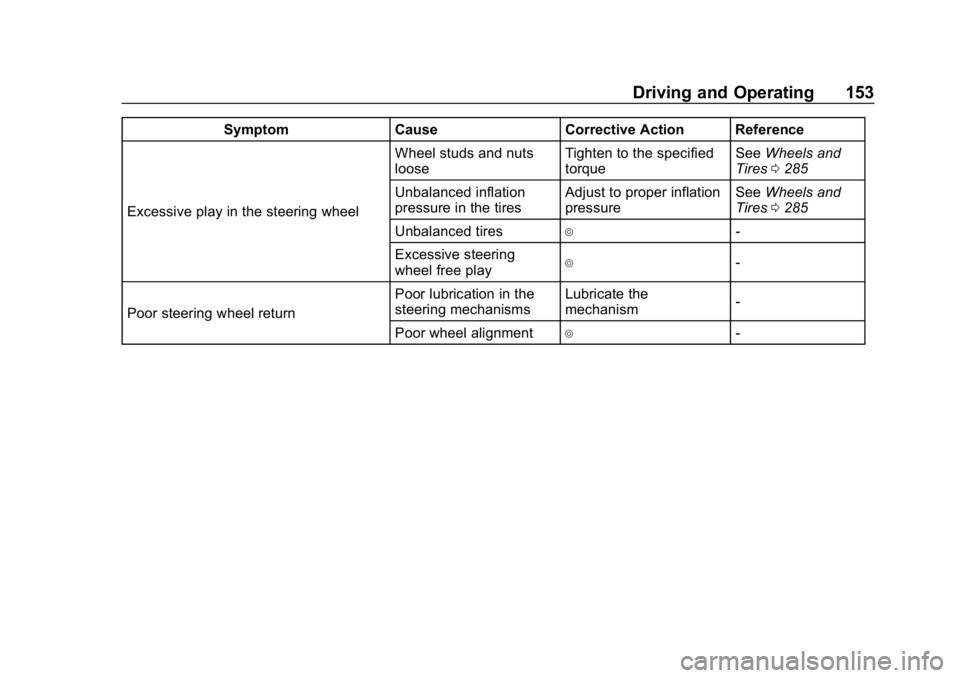
Chevrolet Low Cab Forward 5.2L Diesel Engine 4500 HD/XD/5500 HD/XD
Owner Manual (GMNA-Localizing-U.S.-13337621) - 2020 - crc - 12/5/18
Driving and Operating 153
SymptomCauseCorrective Action Reference
Excessive play in the steering wheel Wheel studs and nuts
loose
Tighten to the specified
torqueSee
Wheels and
Tires 0285
Unbalanced inflation
pressure in the tires Adjust to proper inflation
pressureSee
Wheels and
Tires 0285
Unbalanced tires
4-
Excessive steering
wheel free play
4-
Poor steering wheel return Poor lubrication in the
steering mechanisms
Lubricate the
mechanism
-
Poor wheel alignment
4-
Page 202 of 374

Chevrolet Low Cab Forward 5.2L Diesel Engine 4500 HD/XD/5500 HD/XD
Owner Manual (GMNA-Localizing-U.S.-13337621) - 2020 - crc - 12/5/18
Driving and Operating 201
Driving conditionsSelector lever position
Normal uphill road D (overdrive off switch ON)
Steep uphill, steep slope, mountain
road with many sharp curves 2 or 1
Long uphill road 2
Downhill driving:
Do not overuse the foot brake. This
will cause the brakes to overheat,
reducing their effectiveness. On
long downward slopes or sharp
downhill sections of road, use the
engine brake together with the foot
brakes to control the speed.
When the selector lever is in the D
position, you can drive with the
overdrive off switch ON to allow a
gentle engine brake to be applied.
Push the overdrive off switch to the
ON position at speeds below
101 km/h (63 MPH) to increase
engine braking action when
traveling downgrade. You can increase engine braking by
driving with the selector lever in the
2 position.
To apply a stronger engine brake on
sharp downhill sections, shift the
selector lever to the 1 position when
required.
See
Control of a Vehicle 0130.
Driving at Low Speeds for
Sustained Periods
Any low speed applications such as
sweeper, road marking machinery,
trash collectors, highway striping or
moving, etc. require the following
treatment to prevent the automatic
transmission fluid (ATF) from
overheating:
Select 1 position during low speed
operation under 18 km/h (11 MPH). Select 2 position during low speed
operation under 36 km/h (22 MPH).
See
Automatic Transmission Fluid
Temperature Warning Light 066.
To Stop Your Vehicle 1. To temporarily stop the vehicle, press the brake pedal firmly
while the selector lever is in D.
2. Use the parking brake as required. Press the brake pedal
firmly, and firmly apply the
parking brake.
If the vehicle is stationary for a
long time, move the selector
lever into the N or P position.
If the selector lever is kept in
D, the temperature of the
automatic transmission fluid
increases due to heat from the
torque converter.
To ensure reliable brake application,
be sure to use your right foot to
press the brake pedal.
When leaving the driver's seat,
follow the When Parking Your
Vehicle procedure.
Page 263 of 374

Chevrolet Low Cab Forward 5.2L Diesel Engine 4500 HD/XD/5500 HD/XD
Owner Manual (GMNA-Localizing-U.S.-13337621) - 2020 - crc - 12/5/18
262 Vehicle Care
Rear Axle (Oil Level
Check)
Rear Axle Differential Gear Oil
The rear axle differential gear oil
level must be checked for its level
and it must be changed according to
the Maintenance Schedule.
Use the oil quantities indicated later
in this section only as guidelines
when changing the rear axle
differential gear oil.
After changing the oil, ensure that it
is at the correct level.
Drained oil must be disposed of in a
method conforming to the regulatory
requirements in your state.Checking the Oil Level
1. Remove the oil level plug.
2. Check that the oil level (1) is
0 mm to 10 mm (0 to 0.4 in)
below the bottom edge of the
oil level plug hole (2). If the oil
level is too low, add oil through
the oil level plug hole.
3. Fasten the oil level plug to the specified torque. Plug
tightening torque is 84 Nm
(8.6 kgFm/62 lb ft).
Any dirt on the plug should be
wiped off before installing it.
Noise Control System
Noise Emissions Warranty
General Motors warrants to the first
person who purchases this vehicle
for purposes other than resale and
to each subsequent purchaser that
this vehicle as manufactured by
General Motors, was designed, built
and equipped to conform at the time
it left General Motors’ s control with
all applicable U.S. EPA Noise
Control Regulations. This warranty
covers this vehicle as designed,
built and equipped by General
Motors, and is not limited to any
Page 296 of 374
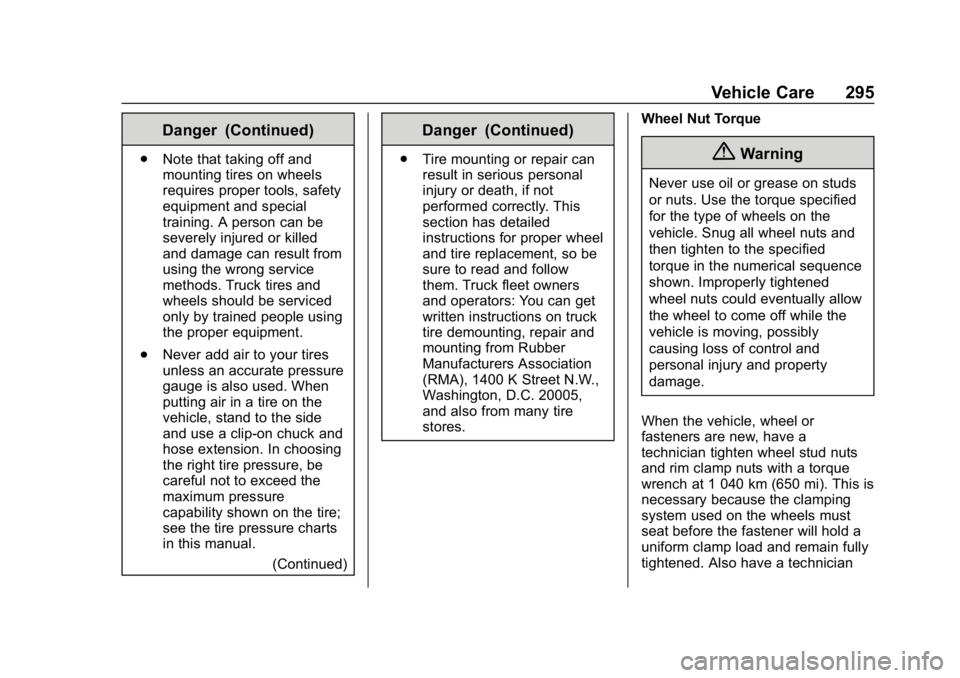
Chevrolet Low Cab Forward 5.2L Diesel Engine 4500 HD/XD/5500 HD/XD
Owner Manual (GMNA-Localizing-U.S.-13337621) - 2020 - crc - 12/5/18
Vehicle Care 295
Danger (Continued)
.Note that taking off and
mounting tires on wheels
requires proper tools, safety
equipment and special
training. A person can be
severely injured or killed
and damage can result from
using the wrong service
methods. Truck tires and
wheels should be serviced
only by trained people using
the proper equipment.
. Never add air to your tires
unless an accurate pressure
gauge is also used. When
putting air in a tire on the
vehicle, stand to the side
and use a clip-on chuck and
hose extension. In choosing
the right tire pressure, be
careful not to exceed the
maximum pressure
capability shown on the tire;
see the tire pressure charts
in this manual.
(Continued)
Danger (Continued)
.Tire mounting or repair can
result in serious personal
injury or death, if not
performed correctly. This
section has detailed
instructions for proper wheel
and tire replacement, so be
sure to read and follow
them. Truck fleet owners
and operators: You can get
written instructions on truck
tire demounting, repair and
mounting from Rubber
Manufacturers Association
(RMA), 1400 K Street N.W.,
Washington, D.C. 20005,
and also from many tire
stores. Wheel Nut Torque{Warning
Never use oil or grease on studs
or nuts. Use the torque specified
for the type of wheels on the
vehicle. Snug all wheel nuts and
then tighten to the specified
torque in the numerical sequence
shown. Improperly tightened
wheel nuts could eventually allow
the wheel to come off while the
vehicle is moving, possibly
causing loss of control and
personal injury and property
damage.
When the vehicle, wheel or
fasteners are new, have a
technician tighten wheel stud nuts
and rim clamp nuts with a torque
wrench at 1 040 km (650 mi). This is
necessary because the clamping
system used on the wheels must
seat before the fastener will hold a
uniform clamp load and remain fully
tightened. Also have a technician
Page 297 of 374
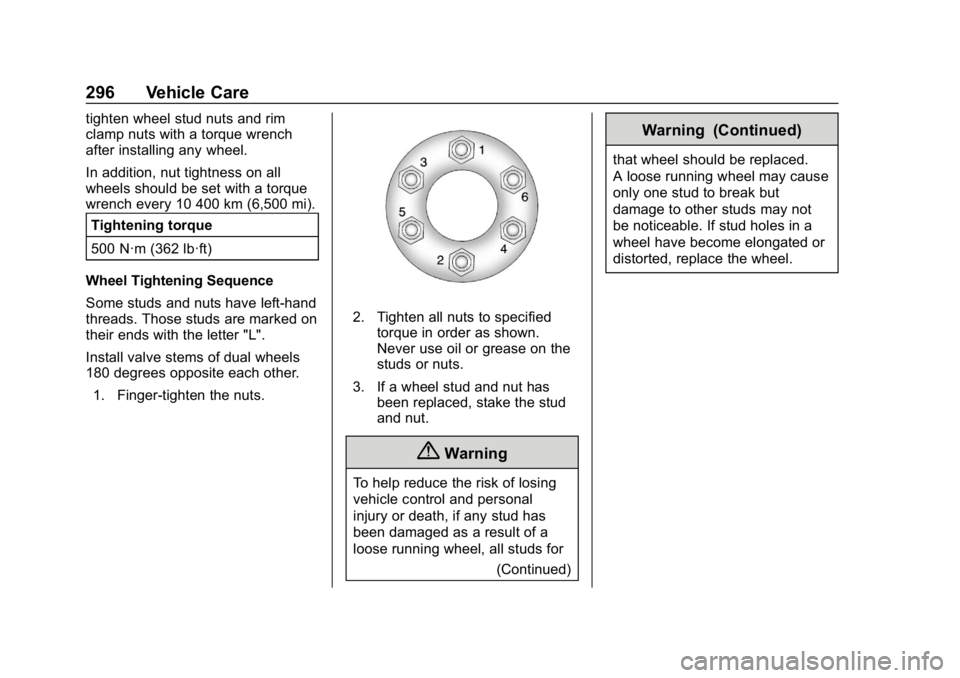
Chevrolet Low Cab Forward 5.2L Diesel Engine 4500 HD/XD/5500 HD/XD
Owner Manual (GMNA-Localizing-U.S.-13337621) - 2020 - crc - 12/5/18
296 Vehicle Care
tighten wheel stud nuts and rim
clamp nuts with a torque wrench
after installing any wheel.
In addition, nut tightness on all
wheels should be set with a torque
wrench every 10 400 km (6,500 mi).Tightening torque
500 N·m (362 lb·ft)
Wheel Tightening Sequence
Some studs and nuts have left-hand
threads. Those studs are marked on
their ends with the letter "L".
Install valve stems of dual wheels
180 degrees opposite each other. 1. Finger-tighten the nuts.
2. Tighten all nuts to specified torque in order as shown.
Never use oil or grease on the
studs or nuts.
3. If a wheel stud and nut has been replaced, stake the stud
and nut.
{Warning
To help reduce the risk of losing
vehicle control and personal
injury or death, if any stud has
been damaged as a result of a
loose running wheel, all studs for
(Continued)
Warning (Continued)
that wheel should be replaced.
A loose running wheel may cause
only one stud to break but
damage to other studs may not
be noticeable. If stud holes in a
wheel have become elongated or
distorted, replace the wheel.
Page 299 of 374
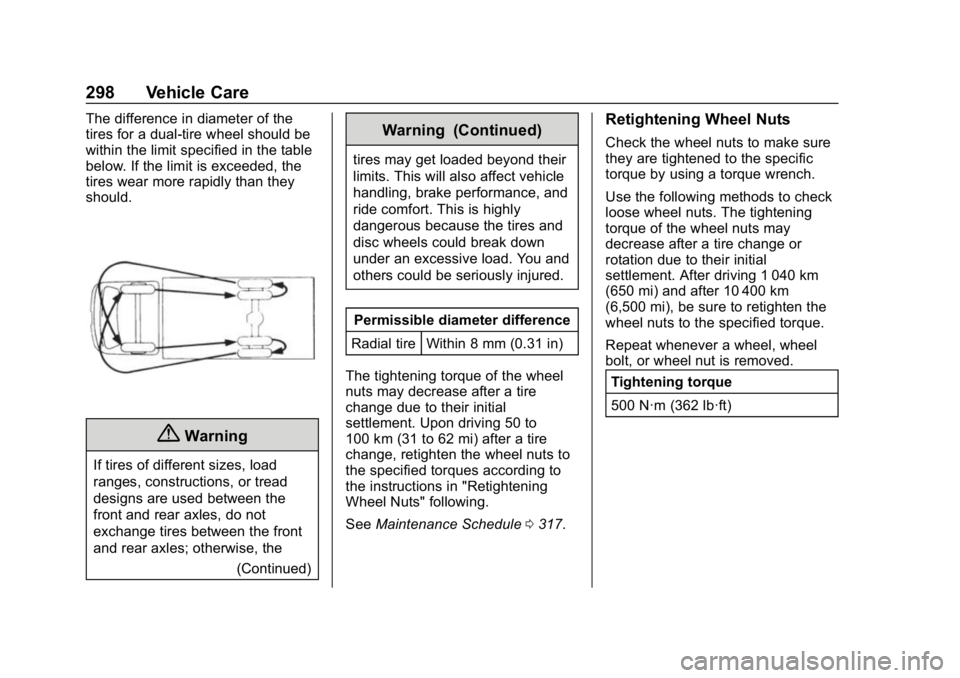
Chevrolet Low Cab Forward 5.2L Diesel Engine 4500 HD/XD/5500 HD/XD
Owner Manual (GMNA-Localizing-U.S.-13337621) - 2020 - crc - 12/5/18
298 Vehicle Care
The difference in diameter of the
tires for a dual-tire wheel should be
within the limit specified in the table
below. If the limit is exceeded, the
tires wear more rapidly than they
should.
{Warning
If tires of different sizes, load
ranges, constructions, or tread
designs are used between the
front and rear axles, do not
exchange tires between the front
and rear axles; otherwise, the(Continued)
Warning (Continued)
tires may get loaded beyond their
limits. This will also affect vehicle
handling, brake performance, and
ride comfort. This is highly
dangerous because the tires and
disc wheels could break down
under an excessive load. You and
others could be seriously injured.
Permissible diameter difference
Radial tire Within 8 mm (0.31 in)
The tightening torque of the wheel
nuts may decrease after a tire
change due to their initial
settlement. Upon driving 50 to
100 km (31 to 62 mi) after a tire
change, retighten the wheel nuts to
the specified torques according to
the instructions in "Retightening
Wheel Nuts" following.
See Maintenance Schedule 0317.
Retightening Wheel Nuts
Check the wheel nuts to make sure
they are tightened to the specific
torque by using a torque wrench.
Use the following methods to check
loose wheel nuts. The tightening
torque of the wheel nuts may
decrease after a tire change or
rotation due to their initial
settlement. After driving 1 040 km
(650 mi) and after 10 400 km
(6,500 mi), be sure to retighten the
wheel nuts to the specified torque.
Repeat whenever a wheel, wheel
bolt, or wheel nut is removed.
Tightening torque
500 N·m (362 lb·ft)
Page 300 of 374
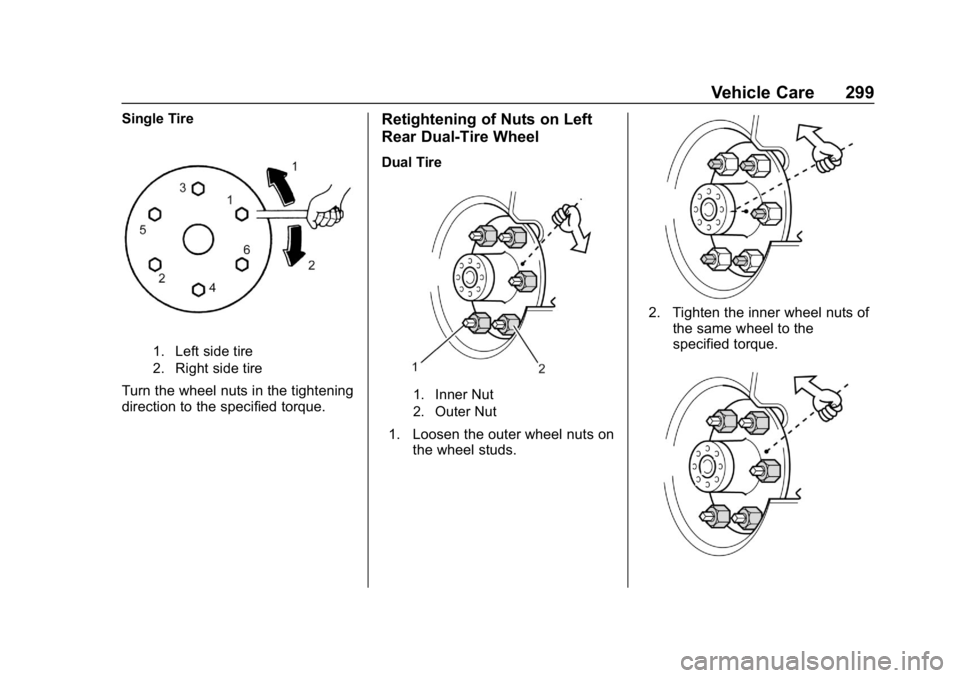
Chevrolet Low Cab Forward 5.2L Diesel Engine 4500 HD/XD/5500 HD/XD
Owner Manual (GMNA-Localizing-U.S.-13337621) - 2020 - crc - 12/5/18
Vehicle Care 299
Single Tire
1. Left side tire
2. Right side tire
Turn the wheel nuts in the tightening
direction to the specified torque.
Retightening of Nuts on Left
Rear Dual-Tire Wheel
Dual Tire
1. Inner Nut
2. Outer Nut
1. Loosen the outer wheel nuts onthe wheel studs.
2. Tighten the inner wheel nuts ofthe same wheel to the
specified torque.
Page 301 of 374
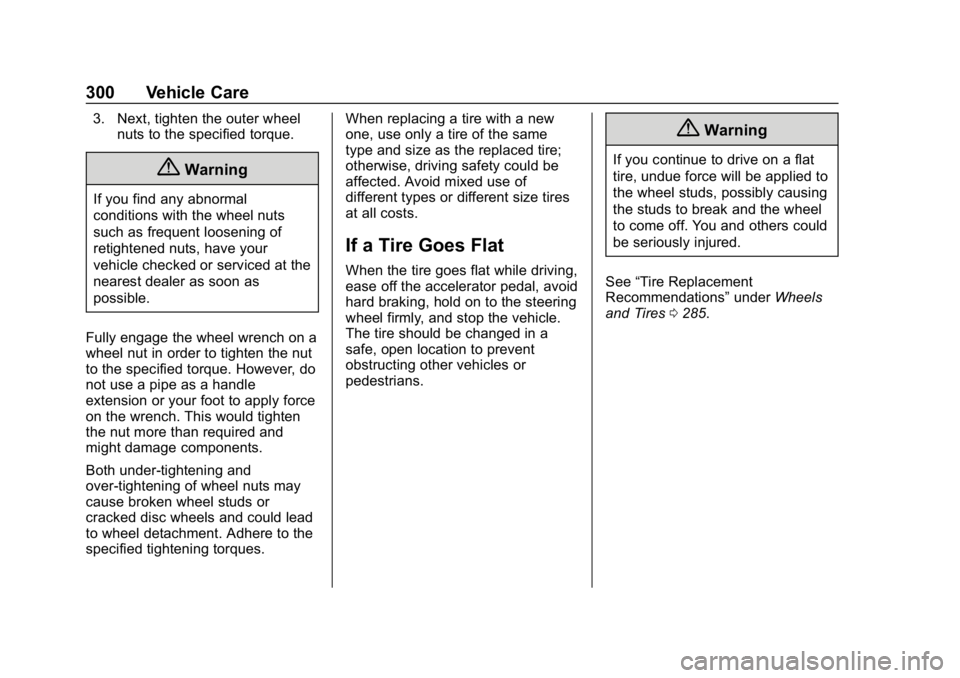
Chevrolet Low Cab Forward 5.2L Diesel Engine 4500 HD/XD/5500 HD/XD
Owner Manual (GMNA-Localizing-U.S.-13337621) - 2020 - crc - 12/5/18
300 Vehicle Care
3. Next, tighten the outer wheelnuts to the specified torque.
{Warning
If you find any abnormal
conditions with the wheel nuts
such as frequent loosening of
retightened nuts, have your
vehicle checked or serviced at the
nearest dealer as soon as
possible.
Fully engage the wheel wrench on a
wheel nut in order to tighten the nut
to the specified torque. However, do
not use a pipe as a handle
extension or your foot to apply force
on the wrench. This would tighten
the nut more than required and
might damage components.
Both under-tightening and
over-tightening of wheel nuts may
cause broken wheel studs or
cracked disc wheels and could lead
to wheel detachment. Adhere to the
specified tightening torques. When replacing a tire with a new
one, use only a tire of the same
type and size as the replaced tire;
otherwise, driving safety could be
affected. Avoid mixed use of
different types or different size tires
at all costs.
If a Tire Goes Flat
When the tire goes flat while driving,
ease off the accelerator pedal, avoid
hard braking, hold on to the steering
wheel firmly, and stop the vehicle.
The tire should be changed in a
safe, open location to prevent
obstructing other vehicles or
pedestrians.
{Warning
If you continue to drive on a flat
tire, undue force will be applied to
the wheel studs, possibly causing
the studs to break and the wheel
to come off. You and others could
be seriously injured.
See “Tire Replacement
Recommendations” underWheels
and Tires 0285.
Page 303 of 374

Chevrolet Low Cab Forward 5.2L Diesel Engine 4500 HD/XD/5500 HD/XD
Owner Manual (GMNA-Localizing-U.S.-13337621) - 2020 - crc - 12/5/18
302 Vehicle Care
Danger (Continued)
Dilute sulfuric acid is used as the
battery fluid. Special care must be
taken to ensure that this fluid
does not come into contact with
skin, clothing, or metal surfaces.
When disconnecting the cables
from the terminals, start with the
negative terminal. When
connecting them, the negative
terminal should be
reconnected last.
You and others could be seriously
injured.
{Warning
For safety and the protection of
the vehicle, do not push-start the
vehicle.(Continued)
Warning (Continued)
Never tow the vehicle to start
because a surge forward when
the engine starts could cause a
collision with the tow vehicle.
Also, this vehicle has a 12-volt
battery, 12-volt starting system
and a negative ground electrical
system; be sure the vehicle or
equipment used to jump start your
engine is also 12-volt. Use of any
other system may damage the
vehicle's electrical components.
Under no circumstances should
the battery's positive and negative
terminals be put in contact with
one another.
When connecting the cables,
under no circumstances should
the clips be allowed to touch each
other.(Continued)
Warning (Continued)
Do not disconnect a battery
terminal with the engine running.
It could cause a breakdown in the
electrical system.
You and others could be seriously
injured.
If you notice battery fluid leaking,
have an inspection carried out
immediately by the nearest dealer.
Diesel engine vehicles have more
than one battery because of the
higher torque required to start a
diesel engine. This procedure can
be used to start a single-battery
vehicle from any of the diesel
vehicle's batteries. However, at low
temperatures, it may not be possible
to start a diesel engine from a single
battery from another vehicle. 1. Use a vehicle that has a charged battery with the same
voltage. Make sure that the
other vehicle also has a 12-volt
starting system, and that it is
Page 320 of 374

Chevrolet Low Cab Forward 5.2L Diesel Engine 4500 HD/XD/5500 HD/XD
Owner Manual (GMNA-Localizing-U.S.-13337621) - 2020 - crc - 12/5/18
Service and Maintenance 319
.Frequent short trips of less than
16 kilometers (10 miles) in sub-
freezing temperatures
. Frequent and extended low-
speed engine operation (door-
to- door deliveries, stop- and- go
traffic, etc.)
. Driving on unpaved roads with
heavy dust
. Towing a trailer
Power Take Off (PTO) and
Extended Idle Use
When the vehicle is used with the
PTO equipment or used in a way
that requires extended idle time,
one hour of use shall be deemed
the same as 33 miles. See Driver
Information Center (DIC) 070 for
hourmeter.
Preventive Maintenance
As any mechanical device operates,
a certain amount of wear occurs.
The amount of wear depends on
certain variables –type and method
of operation and the schedule of
maintenance. These variables may be emphasized as critical to
malfunction but each is dependent
upon the other. For example, if a
vehicle is repeatedly overloaded,
driven at excessive speed or
improperly shifted, no schedule of
maintenance can prevent
malfunction. Also, if a preventive
maintenance schedule is not
followed, or is improperly carried
out, no amount of correct vehicle
operation will prevent malfunction.
If vehicle application, operation and
preventive maintenance schedules
and procedures are followed and
properly carried out, the life of the
vehicle will be greatly extended.
For example, regular attention to the
engine oil is essential. The oil level
must be periodically checked and oil
added whenever needed. Also, the
oil should be changed at the
intervals specified with the proper
quality and viscosity of oil. If your
engine should run excessively low
on oil or if the oil has lost its
lubricating qualities because of old
age, serious engine damage could
occur.
Maintenance Schedule Table
Letters Used to Indicate
Maintenance Service Types
I :
Inspect then clean, repair or
replace as necessary
A : Adjust
R : Replace
T : Tighten to the specified torque
L : Lubricate
C : Clean